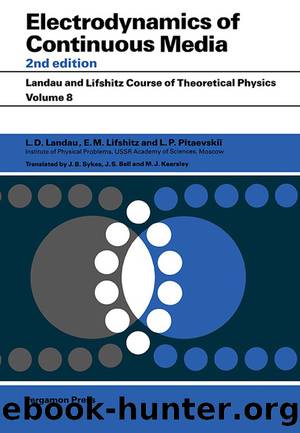Electrodynamics of Continuous Media: Course of Theoretical Physics by L D Landau & E.M. LIFSHITZ

Author:L D Landau & E.M. LIFSHITZ [LANDAU, L.D. & LIFSHITZ, E.M.]
Language: eng
Format: epub
ISBN: 9781483293752
Publisher: Elsevier
Published: 1984-09-15T00:00:00+00:00
(64.8)
The required field H(e) outside the conductor is obtained by subtracting from the solution Hâ² of this latter problem.
The magnetic field thus produced, like any variable field, induces electric currents in the conductor itself. In a simply-connected body, these currents appear in the form of a magnetic moment. In a non-uniformly rotating ring, the effect appears as an e.m.f.âthe StewartâTolman effect.
Misunderstanding may arise from the appearance of the angular velocity Ω itself, and not its time derivative, in formula (64.8). We may therefore emphasize that the above discussion, and therefore the significance here attached to the quantity (64.8), pertain only to non-uniform rotation. When Ω is constant, equation (64.7) with the appropriate boundary condition at infinity is identically satisfied by HⲠ= , and the definition (64.5) then gives H = 0. The magnetic field which arises from the gyromagnetic effect (§36) in uniform rotation is a small quantity which is here neglected.
The derivation has also ignored the deformation of the body which results from non-uniform rotation. It can be seen that including this deformation would not affect the result if the characteristic time of variation of the angular velocity is (as we assume) much longer than the relaxation time of the conduction electrons in the deformation: the electric current in the conductor is due to the gradient of Ï + ζ0/e, where Ï is the field potential and ζ0 the chemical potential of the conduction electrons (see §26). A non-uniform deformation produces a gradient of ζ0, but this is compensated by the electric field which results from the thermodynamic equilibrium condition eÏ + ζ0 = constant.
Download
This site does not store any files on its server. We only index and link to content provided by other sites. Please contact the content providers to delete copyright contents if any and email us, we'll remove relevant links or contents immediately.
| Atomic & Nuclear Physics | Particle Physics |
The Complete Stick Figure Physics Tutorials by Allen Sarah(7253)
Secrets of Antigravity Propulsion: Tesla, UFOs, and Classified Aerospace Technology by Ph.D. Paul A. Laviolette(5229)
Thing Explainer by Randall Munroe(3838)
The River of Consciousness by Oliver Sacks(3488)
The Order of Time by Carlo Rovelli(3088)
How To by Randall Munroe(2956)
A Brief History of Time by Stephen Hawking(2902)
I Live in the Future & Here's How It Works by Nick Bilton(2892)
The Great Unknown by Marcus du Sautoy(2605)
What If?: Serious Scientific Answers to Absurd Hypothetical Questions by Randall Munroe(2576)
Midnight in Chernobyl by Adam Higginbotham(2424)
Blockchain: Ultimate Step By Step Guide To Understanding Blockchain Technology, Bitcoin Creation, and the future of Money (Novice to Expert) by Keizer Söze(2402)
Networks: An Introduction by Newman Mark(2292)
The Meaning of it All by Richard Feynman(2258)
Easy Electronics by Charles Platt(2242)
The Tao of Physics by Fritjof Capra(2195)
Midnight in Chernobyl: The Untold Story of the World's Greatest Nuclear Disaster by Adam Higginbotham(2119)
When by Daniel H Pink(2050)
Introducing Relativity by Bruce Bassett(2040)
